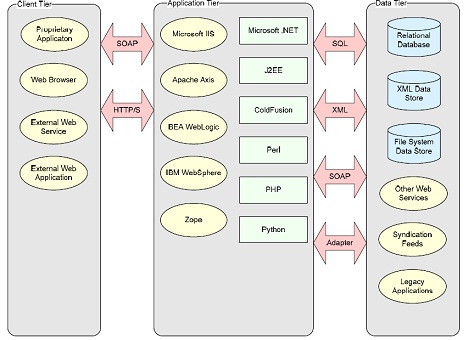Web Services
‘Web services’ is the name given to a technology for providing loosely coupled and interoperable communications between computer systems over a network. Applications of this technology include enterprise application integration, enabling communications between distributed systems and interoperability with partners or other businesses. The major benefits of using web services are platform independence, flexibility and ease of maintenance, which are the result of the open standards employed and the simplified underlying request-response concept that avoids the complexity of other distributed technologies such as CORBA.
Web services communications are primarily XML-based and essentially provide the ability to make RPC-like function calls between remote systems, regardless of their underlying platform. Specifically, SOAP over HTTP is the most common implementation of a web service. Supporting protocols such as UDDI [OASIS 1] and WSDL [W3C 1] provide discovery and description services that contain enough information for client applications to be built to utilise the service.
The ability to expose functionality through HTTP provides the benefit of minimal firewall configuration but also has the effect of circumventing firewall rules that may restrict unauthorised access to these functions. The addition of UDDI and WSDL allow remote users to easily locate and use the functionality provided. This exposure poses a far greater threat than was present in the previous generation of distributed technologies that typically used proprietary binary encoding schemes and restrictive firewall rule sets to limit access.
Web services communication is based upon the Simple Object Access Protocol (SOAP). SOAP is an XML-based information packaging definition which can be used for exchanging structured and typed information between peers in a distributed environment, relying on Internet transport protocols such as HTTP. Because SOAP is standards based, it also provides interoperability in heterogeneous environments.
The most relevant documents are
“SOAP Version 1.2 Part 0: Primer” [W3C 2]
“SOAP Version 1.2 Part 1: Messaging Framework” [W3C 3]
“SOAP Version 1.2 Part 2: Adjuncts” [W3C 4].


can i know something about lisa service virtualization responders concepts